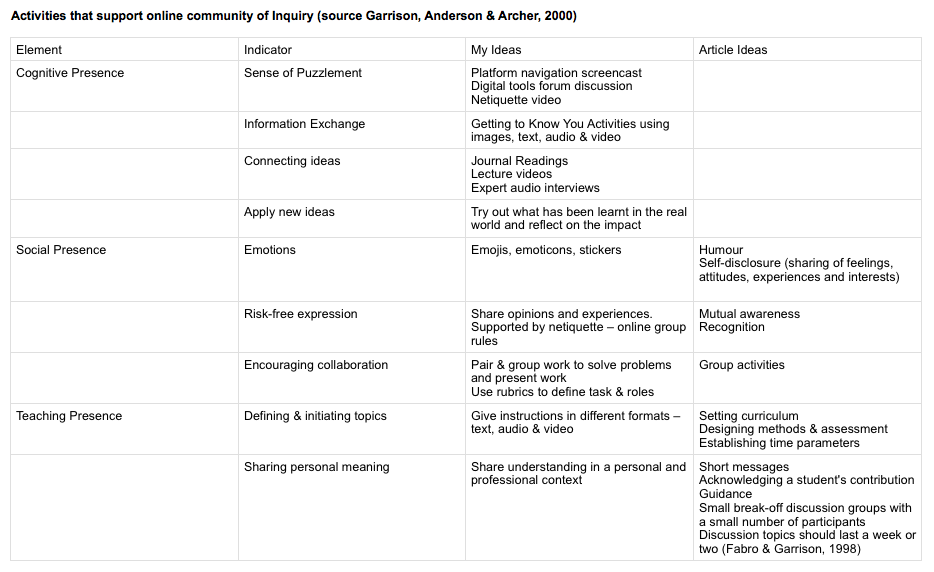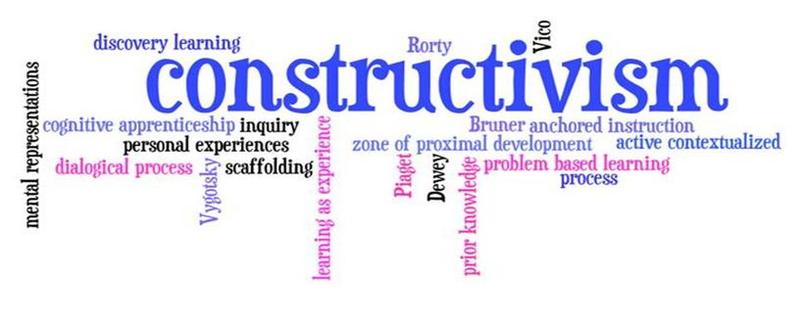
Activities that support online community of inquiry
In my previous post I listed some of my own ideas to facilitate cognitive, social and teacher presence in an online learning environment. I thought it would be interesting to put them side-by-side with some of the examples given in the paper. Although I do not plan to run a higher education online course as of today. You never know, it could prove useful in the future!
Now more reflections on computer conferencing in higher education.
Oral vs. Text-based Communication
Critical Enquiry in a Text-Based Environment: Computer Conferencing in Higher Education by Garrison, Anderson & Archer (2000) reminds us that “oral critical discourse can facilitate critical thinking – at least in well-moderated small seminar groups.” (p90). And then contrasts this with the fact that “writing may be crucial when the objective is to facilitate thinking about complex issues and deep, meaningful learning.” (p90-91). Back in 2000 when this paper was written, perhaps the technology of the day could not transmit non-verbal and paralinguistic cues in a satisfying way. However, times have changed, and technology has developed to a point where we all carry mobile devices that allow us to connect face-to-face online in real time. Not only by text, but also through audio and video messages, as well as voice and video calls. The positive aspects of oral communication such as facial expression & tone of voice which were missing in text-based communication due to technological constraints two decades ago, can now be easily and successfully replicated. And thus I think a ‘happy medium’ can be found, with the exploitation of current technologies to integrate images, audio and video into online courses, at higher education level or otherwise, to create a truly balanced educational experience. Indeed, the idea of the blended learning environment as the best of both worlds is an idea I ruminated back when I interviewed my mother about her first experience with online learning.

The value of Collaborative Constructivism
The authors have a collaborative constructivist approach to teaching and learning. “This perspective views an educational experience…as a collaborative communication prices for the purpose of constructing meaningful and worthwhile knowledge.” (p92). This reminds me of project or problem based learning, where an awareness of the environment is sparked, and the focus becomes solving real-life local (and global) problems. Indeed, “collaboration must draw learners into a shared experience for the purposes of constructing and confirming meaning” (p95). Gamification, a concept that blurs the line between games and education, comes to mind. In fact, a school in New York aptly named Quest to Learn encapsulates this idea by enabling students to interact with in-class topics by playing and creating games.
My own enthusiasm for incorporating elements of gamification in my teaching practice was boosted while reading about Virtual Worlds during my online distance Masters course. I immediately signed up to ClassCraft, an online platform that helps teachers gamify their classroom. But alas, I never followed through, preferring instead to integrate simple digital tools like more into my teaching. For example, I used the online voice recorder vocaroo with my students to facilitate speaking homework. I also stored text prompts for homework on Padlet, a digital canvas that works like a sheet of paper where you may store documents, links, images etc. Those were good first steps – but I really hope to do more to gamify learner experiences in the future. Watch this space!

Final Thoughts: Teacher Presence
“Certainly, there is truth in the view that it is the instructional design and how we use technology to create a learning environment that is paramount in achieving quality learning outcomes (Anderson & Garrison, 1995; Clark, 1994) (p92)” So we have a clear conceptual framework, but we want the learning journey or experience to flow and feel natural. This needs to be thoughtfully designed, narrowed and streamlined for maximum effect in a reasonable time. And this responsibility falls on the shoulder of the Teacher. She needs to be aware of, not only the availability and affordances of technologies, but also the strengths and weaknesses of her own students’ knowledge as well as her own personal & professional limitations (i.e. lack of training or just lack of confidence) No easy task! In fact this article states that “the teachers responsibility is to facilitate reflection and discord by presenting content, questions and proactively guiding and summarising the discussion as well as confirming understanding through various means of assessment and feedback” (p102). Is that all?! In many ways I feel that what a ‘teacher’ does is often over-simplified and the complexity of our work is misunderstood. Professional training is often lacking which means that a desire to integrate technological solutions into teaching practice is often feared without the proper support. My personal experience is that I had to seek out my own way forward, first in the form of general (and free) online courses, before finally settling upon a paid-for academic course. How this new found knowledge and experience will manifest itself remains to be seen!
Reference
Garrison, D.R., Anderson, T., & Archer, W. (2000). Critical Enquiry in a Text-Based Environment: Computer Conferencing in Higher Education. The Internet and Higher Education 2(2-3), 87-105.
Image
From http://rozyparletteidporfolio.weebly.com/uploads/3/0/8/1/30812307/5904665_orig.jpg
